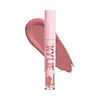What's inside
What's inside
 Key Ingredients
Key Ingredients

 Benefits
Benefits

No benefits
 Concerns
Concerns

No concerns
 Ingredients Side-by-side
Ingredients Side-by-side

Hydrogenated Polyisobutene
EmollientIsononyl Isononanoate
EmollientEthylene/Propylene/Styrene Copolymer
Diisostearyl Malate
EmollientPolybutene
Alumina
AbrasiveAroma
Butylene/Ethylene/Styrene Copolymer
C20-24 Olefin
Skin ConditioningGeraniol
PerfumingGlycerin
HumectantHydroxymethoxyphenyl Propylmethylmethoxybenzofuran
Skin ConditioningLimonene
PerfumingLinalool
PerfumingPentaerythrityl Tetra-Di-T-Butyl Hydroxyhydrocinnamate
AntioxidantSynthetic Fluorphlogopite
Tocopheryl Acetate
AntioxidantTriethoxycaprylylsilane
CI 19140
Cosmetic ColorantCI 15850
Cosmetic ColorantCI 77891
Cosmetic ColorantBHT
AntioxidantHydrogenated Polyisobutene, Isononyl Isononanoate, Ethylene/Propylene/Styrene Copolymer, Diisostearyl Malate, Polybutene, Alumina, Aroma, Butylene/Ethylene/Styrene Copolymer, C20-24 Olefin, Geraniol, Glycerin, Hydroxymethoxyphenyl Propylmethylmethoxybenzofuran, Limonene, Linalool, Pentaerythrityl Tetra-Di-T-Butyl Hydroxyhydrocinnamate, Synthetic Fluorphlogopite, Tocopheryl Acetate, Triethoxycaprylylsilane, CI 19140, CI 15850, CI 77891, BHT
Isododecane
EmollientNylon-12
Boron Nitride
AbsorbentAcrylates Copolymer
Hydrogenated Polyisobutene
EmollientIsononyl Isononanoate
EmollientQuaternium-18 Hectorite
Sodium Magnesium Silver Phosphate
AntimicrobialEthylene/Propylene/Styrene Copolymer
Triethoxycaprylylsilane
Tocopheryl Acetate
AntioxidantButylene/Ethylene/Styrene Copolymer
BHT
AntioxidantPhenoxyethanol
PreservativeCI 77891
Cosmetic ColorantCI 19140
Cosmetic ColorantCI 15850
Cosmetic ColorantIron Oxides
Isododecane, Nylon-12, Boron Nitride, Acrylates Copolymer, Hydrogenated Polyisobutene, Isononyl Isononanoate, Quaternium-18 Hectorite, Sodium Magnesium Silver Phosphate, Ethylene/Propylene/Styrene Copolymer, Triethoxycaprylylsilane, Tocopheryl Acetate, Butylene/Ethylene/Styrene Copolymer, BHT, Phenoxyethanol, CI 77891, CI 19140, CI 15850, Iron Oxides
Ingredients Explained
These ingredients are found in both products.
Ingredients higher up in an ingredient list are typically present in a larger amount.
BHT is a synthetic antioxidant and preservative.
As an antioxidant, it helps your body fight off free-radicals. Free-radicals are molecules that may damage your skin cells.
As a preservative, it is used to stabilize products and prevent them from degrading. Specifically, BHT prevents degradation from oxidation.
The concerns related to BHT come from oral studies; this ingredient is currently allowed for use by both the FDA and EU.
However, it was recently restricted for use in the UK as of April 2024.
Learn more about BHTWe don't have a description for Butylene/Ethylene/Styrene Copolymer yet.
Ci 15850 is the pigment color red. It is an azo dye and created synthetically.
Azo dyes need to be thoroughly purified before use. This allows them to be more stable and longer-lasting.
This ingredient is common in foundations, lipsticks, and blushes. This color is described as brown/orangey red.
It has many secondary names such as Red 6 and Red 7. According to a manufacturer, Red 6 usually contains aluminum.
Learn more about CI 15850CI 19140 is also known as Tartrazine. Tartrazine is a synthetic dye used in cosmetics, foods, and medicine to add a yellow color.
Tartrazine is created from petroleum and is water-soluble.
Some people may experience allergies from this dye, especially asthmatics and those with an aspirin intolerance.
Learn more about CI 19140Ci 77891 is a white pigment from Titanium dioxide. It is naturally found in minerals such as rutile and ilmenite.
It's main function is to add a white color to cosmetics. It can also be mixed with other colors to create different shades.
Ci 77891 is commonly found in sunscreens due to its ability to block UV rays.
Learn more about CI 77891We don't have a description for Ethylene/Propylene/Styrene Copolymer yet.
Hydrogenated Polyisobutene is a synthetic polymer. Polymers are compounds with high molecular weight. Hydrogenated Polyisobutene is an emollient and texture enhancer.
In one study, Hydrogenated Polyisobutene showed better skin hydration levels than Caprylic/Capric Triglyceride. As an emollient, it helps keep your skin soft and hydrated by trapping moisture in.
Hydrogenated Polyisobutene is often used as a mineral oil replacement.
Learn more about Hydrogenated PolyisobuteneIsononyl Isononanoate is a synthetic skin-conditioner and texture enhancer. It is created from nonanoic acid, a fatty acid found in cocoa and lavender oil.
As an emollient, Isononyl Isononanoate helps keep your skin soft and smooth. This is because emollients create a barrier on the skin to trap moisture in.
Isononyl Isononanoate helps give products a velvet feel and improves spreadability.
Learn more about Isononyl IsononanoateTocopheryl Acetate is AKA Vitamin E. It is an antioxidant and protects your skin from free radicals. Free radicals damage the skin by breaking down collagen.
One study found using Tocopheryl Acetate with Vitamin C decreased the number of sunburned cells.
Tocopheryl Acetate is commonly found in both skincare and dietary supplements.
Learn more about Tocopheryl AcetateTriethoxycaprylylsilane is a silicone used to bind and stabilize ingredients.
As an emulsifier, it helps prevent ingredients from separating. This can help elongate the shelf life of products.
Triethoxycaprylylsilane is often used to coat mineral sunscreens ingredients to help give a better feel. It also helps reduce oxidative stress in sunscreens.
Learn more about Triethoxycaprylylsilane